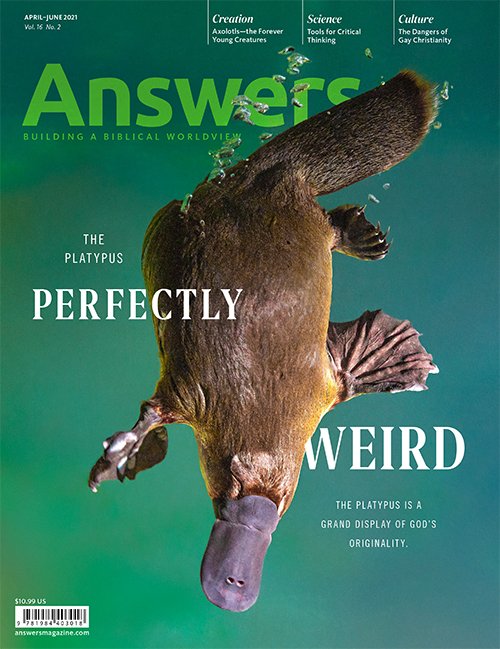Platypus: One of a Kind
The platypus may not fit into a manmade box, but it fits perfectly in God’s design.
In October of 2020 scientists started seeing the platypus in a whole new light when they discovered that its fur is biofluorescent, glowing green and blue under ultraviolet light. Scientists don’t yet understand how this little Australian creature achieves its glow, much less why the glow is useful. But it’s just one more fascinating feature that confirms this undeniable truth: the platypus is weird.
The platypus makes its home in riverbeds and along streams on the eastern coast of Australia and the island of Tasmania. It has a bill like a duck, has a tail like a beaver, and lays eggs like a reptile. When European scientists first encountered the platypus in the late 1700s, they thought the creature was a prank. When presented with a taxidermized platypus, one scientist was so convinced of the forgery, he tried to remove the bill with a pair of scissors. But looking like a beaver with a stitched-on duck bill was merely the beginning of the platypus’ strangeness. Where did this creature fit in?
In the 1700s, Carl Linnaeus created a system for classifying living things, the basis for our modern classification system—kingdom, phylum, class, order, family, genus, species. In part, this organization fulfills the dominion mandate by bringing order to the vastness of nature, allowing us to better steward creation.
When God created the heavens and the earth, he didn’t do it according to man’s taxonomic system.
But sometimes living things don’t fit so neatly into our manmade systems. The platypus is the poster child for creatures that cannot be cleanly and clearly classified. Though this unique animal is classified as a mammal, the more we learn about the platypus, the less mammalian it seems. This little creature is a reminder that when God created the heavens and the earth, he didn’t do it according to man’s taxonomic system. Though the platypus doesn’t fit perfectly in the boxes we’ve contrived, it functions according to the Creator’s wise design.
For the Grammarians
Many people familiar with Latin endings think that the plural of platypus should be platypı̄ . After all, the plural of alumnus is alumnı̄ . Since platypus and alumnus both end in the same suffix -us, shouldn’t they be pluralized the same way?
Technically, yes. Singular Latin words ending in -us use the -ı̄ ending to denote the plural. However, English speakers often disregard what is correct and simplify language by adjusting it to fit more easily into English. Therefore, platypus is most commonly pluralized as platypuses, though platypı̄ is a secondary and recognized spelling.
You’ve seen this before: the word bonus is the Latin word for “good,” the plural of which we spell bonuses. (Only the Roman Empire would have given out Christmas bonı̄ had they celebrated Christmas.)
Like the platypus itself, language can be delightfully complicated but endlessly fascinating!
According to Their Kind
Genesis 1 says that God created animals according to their kinds. That means that when God created the bear kind in Eden, he didn’t create the polar bear or grizzly bear species but an original bear kind from which the species diversified.
Likewise, God brought Noah a pair (or, in some cases, seven pairs) of each kind of air-breathing, land-dwelling animal and bird to take on the ark to preserve them from the worldwide flood of judgment. Because Noah took two members of the bear kind, now, about 4,000 years later, we have eight species of bears which diversified from that kind.
According to the fossil record, the platypus has always been a distinct kind. The fossil record indicates that several species have gone extinct, and we have discovered just one species of platypus today. Of course, before the fall, like all other creatures, the platypus was an herbivore with no need for defensive features such as venom (yes, the platypus is venomous, but more on that later). But for life in a post-fall world, God made sure this creature had the features it needed to thrive—a unique set of characteristics resembling several different classes of animals.
Fitting the Bill
The platypus is more like a bird than you might expect. The most obvious similarity between birds and the platypus is the bill. In addition to looking like a duck bill, the platypus’ bill functions the same as some bird bills. Aquatic birds (and the adult platypus) do not have teeth and must mash up their food with plates in the bills. The platypus also uses bits of gravel to fully chew its food, not unlike the function of a bird’s gizzard. Bills also are quite handy for straining out critters like shrimp, crayfish, and larvae that make up the platypus’ diet.
The way the platypus cares for its young (called puggles) resembles how birds treat their chicks. First off, the female digs an extra-long burrow. At the back, she builds a nest of fallen leaves and reeds from the riverbank. When she leaves the nest, she plugs the path in several spots to protect her puggles from the elements. Like chicks, the puggles must be cared for until they reach four months old and can leave the nest.
The final major similarity between birds and the platypus is that both have a single ventral opening, known as a cloaca. In fact, the platypus’ order monotreme literally means “single hole.” Most mammals have one opening for urine, one for fecal matter, and one for giving birth. The cloaca, however, is the only orifice in the platypus’ posterior for digestive and reproductive use. Unlike birds, the platypus does urinate. (Because they lack a bladder, birds recycle any extra fluid and deposit the salt in their intestines.) Still, even with this difference, the platypus’ inner plumbing leading to a cloaca is much like a bird’s.
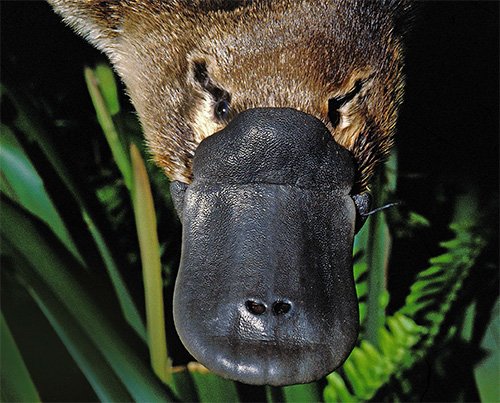
The platypus’ bill is covered with specialized nerve endings that allow the platypus to detect electric signals from the movement of prey.
Fishy Similarities
Birds are not the only group to share similar designs with the platypus. Surprisingly, platypuses are also a bit like fish. The platypus spends much of its time in the water. Like some fish, the platypus possesses a sixth sense in its bill. The bill is covered with specialized nerve endings that allow the platypus to detect low frequency electric signals, such as those generated by muscular contractions. When hunting during a dive, the platypus is searching for the movement of its prey—just like sharks and other fish.
The platypus and fish also have similarly constructed eyes. Most mammals have cones and rods in their eyes. The platypus, however, has double cones, like most fish and other vertebrates. Although no one knows exactly what, if any, benefits arise from double-coned vision, scientists speculate that such sight can detect luminescence, motion, or other such oddities, particularly underwater.
Another striking similarity between the platypus and some fish is the lack of a stomach. The platypus’ gullet (esophagus) connects directly to the small intestine, forgoing the digestive process in the stomach. The platypus’ diet is generally simple enough that the creature doesn’t need extra digestion.
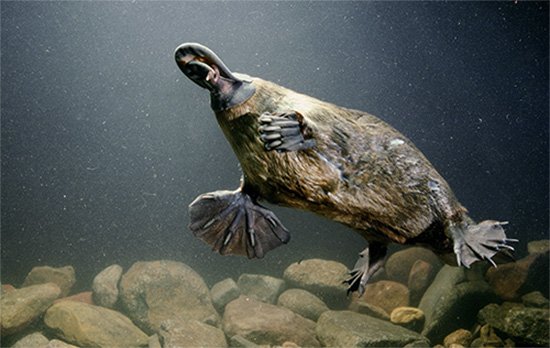
Photo © NHPA/PHOTOSHOT/SCIENCE SOURCE
A platypus hunts up to 12 hours a day, eating about 20% of its body weight in shrimp, crayfish, larvae, and other prey from the riverbed.
Reptile Resemblances
Reptiles are cold-blooded and platypuses are warm-blooded. Still, they find ways to be similar. Though most mammals give birth to live young, the platypus lays soft, leathery eggs like reptiles. Platypus egg clutches are fewer in number than most reptiles, though the survival rate to adulthood is higher in platypuses.
Egg similarities are not the only shared feature between reptiles and platypuses. Since they also share skeletal structures, the platypus walks like many reptiles, including the crocodile. It has extra bones in its shoulder girdle, and its legs are located on the sides of its body (like a lizard) instead of underneath it (like a cat). The platypus has webbing between its toes, not unlike an alligator or turtle. The webbing is immensely helpful while the platypus swims, but God gave the platypus retractable webbing, helpful for walking or digging.
The clearest similarity is in the platypus’ venom. Snakes can be venomous, with toxicity ranging from merely painful to fatal for humans. The platypus delivers its venom through ankle spurs. Though both male and female platypuses are born with ankle spurs, only males have venom glands in a sack on their back legs. While not lethal to humans, the venom can paralyze smaller creatures, like dogs, and cause extreme pain that can last for months since there is no known antidote.
Mammalian Comeback
With so many atypical features, why would anyone decide to label the platypus a mammal in the first place?
Well, perhaps the most obvious reason is the dark brown fur that covers nearly every inch of the platypus. Fur (or hair) is strictly a mammalian trait. Though all fur is used to keep mammals warm, the platypus’ dense, waterproof fur traps a layer of insulating air to help protect the platypus against hypothermia when it dives for food in cold water.
Mammals are also the only creatures that nurse their young. Though puggles are hatched instead of born, they do not start eating worms and larvae right away. But nursing poses a problem since the puggles have bills instead of mouths. Instead of giving female platypuses teats, God designed the platypus’ milk to ooze through the skin into pools the puggles can lap up. Despite the unusual delivery method, the rest of the nursing process functions just like any other mammal, ending in the young being weaned and going off on their own.
The platypus has one more design feature that is present only in mammals—three bones in the inner ear. Among the smallest bones in the body, the hammer, anvil, and stirrup bones are vital to mammalian hearing. As sound enters the ear, the vibrations cause the bones to move against each other. This in turn agitates the fluid in the inner ear’s cochlea, sending the information on for the brain to interpret. These little bones show up in all mammals, including the platypus.
Perfectly Weird
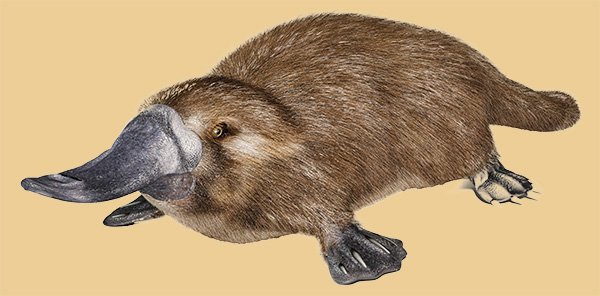
Specialized Bill
- The platypus uses its bill to strain out small prey. Without teeth, the platypus mashes its food with plates in the bill. The bill is covered with specialized nerve endings that allow the platypus to detect low frequency electric signals, sent out when prey moves.
- While hunting, the platypus stores its prey in cheek pouches at the back of its jaws to consume when the platypus reaches the surface.
All-Purpose Legs and Feet
- The webbing between the platypus’ toes helps the creature swim. On land, the webbing retracts to reveal claws, helpful for walking and digging.
- The platypus has extra bones in its shoulder girdle, and its legs are located on the sides of its body instead of underneath it. With this skeletal structure, the platypus walks like many reptiles.
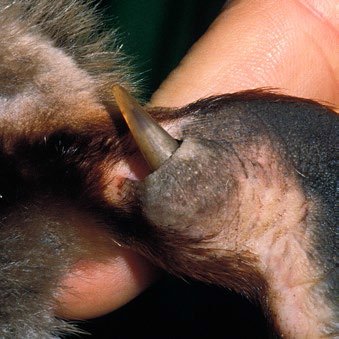
Venomous Spur
Both male and female platypuses are born with ankle spurs, but only the males retain them to adulthood and develop venom sacks.
Tactile Tail
This beaver-like tail stores up fat and helps warm the incubating eggs. The platypus also uses the tail to carry leaves for building its burrows.
No Stomach
The platypus’ gullet (esophagus) connects directly to the small intestine, forgoing the digestive process of a stomach.
Egg Laying
Though most mammals give birth to live young, the platypus lays soft, leathery eggs like reptiles.
Mother's Milk
The platypus’ milk oozes through its skin into pools the young can lap up.
Calling a Winner
Evolutionists point to the platypus as an example of a creature that reveals how mammals diverged from reptiles. In fact, one researcher went so far as to say the platypus was the first species to diverge from reptile to mammal. But the shared features don’t point to a shared ancestor between mammals and reptiles. According to the fossil record, the platypus has always been a platypus. The conglomeration of features simply shows God’s order and creativity. Though weird and composed of seemingly random features, the platypus’ myriad parts function fluidly as a whole so that if any of its pieces were missing, the platypus couldn’t survive. It is perfectly suited to its habitat and ecosystem. Though it appears as a collage of features pulled from several kinds of animals, the platypus is its own distinct kind, one of the grandest displays of God’s originality. Where else could the platypus have come from, save a wise, ever-surprising Creator whose sometimes eccentric designs operate perfectly outside our systems of order and within his own?
Other Oddities
The platypus isn’t the only creature that confounds our classification system. It’s one of many unusual creatures that don’t quite fit in the boxes we’ve constructed. Like the platypus, these animals challenge our ideas about species, but also remind us of our creative God—the one who really makes the rules.
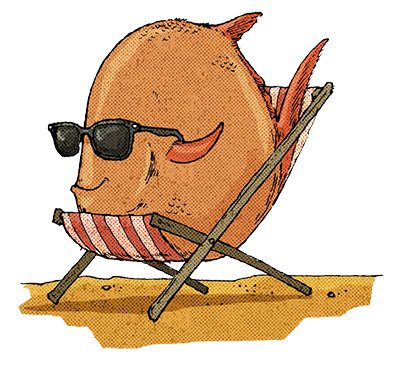
Art by Wesley Merritt
Moonfish
Moonfish are the only known fully warm-blooded fish. They live in oceans around the world, hundreds of feet below the surface. In these cold ocean depths, moonfish benefit from heated blood that circulates through their bodies. Other fish that inhabit these depths tend to be slow, conserving energy by ambushing prey rather than giving chase. But a warm-blooded advantage helps moonfish swim faster and react quicker, giving them the competitive edge.

Art by Wesley Merritt
Beetle Cockroach
Unlike some other cockroaches that lay eggs, beetle cockroaches give birth to live young. The embryonic cockroaches live in brood sacs inside the mother. Throughout their development, she produces a nutrient-packed “milk” before birthing 7–13 nymphs at a time. According to scientists, the “cockroach milk,” a yellow-colored substance composed of fats, sugars, and proteins, is among the most nutritious substances on the planet.

Art by Wesley Merritt
Kiwi
Because of their unusual behaviors and characteristics, these nocturnal, flightless birds are sometimes referred to as honorary mammals. They have shaggy feathers that look like hair and cat-like whiskers that help them find their way in the dark. Kiwis burrow like badgers and have two ovaries like mammals (most birds have just one ovary). Kiwis lay bigger eggs than almost any other bird in proportion to their body size.

Art by Wesley Merritt
Pangolin
These scaly creatures are mammals, not reptiles like many people think. Pangolins are the only mammals covered in scales. This armor helps protect them from predators. When threatened, pangolins curl up into a tight ball. They use their sharp, scaly tail and release a pungent fluid to defend themselves. Pangolins are sometimes called “scaly anteaters” because they have a long snout and long tongue for lapping up ants and termites.
Answers Magazine
April–June 2021
Recommended Resources

Answers in Genesis is an apologetics ministry, dedicated to helping Christians defend their faith and proclaim the good news of Jesus Christ.
- Customer Service 800.778.3390
- © 2024 Answers in Genesis



